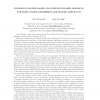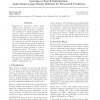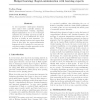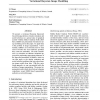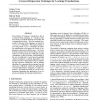100
Voted
ICML
2005
IEEE
16 years 1 months ago
2005
IEEE
T ORDER REGRESSION (EXTENDED ABSTRACT) Kurt Driessensa Saso Dzeroskib a Department of Computer Science, University of Waikato, Hamilton, New Zealand (kurtd@waikato.ac.nz) b Departm...
96
Voted
ICML
2005
IEEE
16 years 1 months ago
2005
IEEE
This paper presents a search algorithm for finding functions that are highly correlated with an arbitrary set of data. The functions found by the search can be used to approximate...
110
click to vote
ICML
2005
IEEE
16 years 1 months ago
2005
IEEE
Mappings to structured output spaces (strings, trees, partitions, etc.) are typically learned using extensions of classification algorithms to simple graphical structures (eg., li...
ICML
2005
IEEE
16 years 1 months ago
2005
IEEE
In non-cooperative multi-agent situations, there cannot exist a globally optimal, yet opponent-independent learning algorithm. Regret-minimization over a set of strategies optimiz...
76
Voted
ICML
2005
IEEE
16 years 1 months ago
2005
IEEE
We present a variational Bayesian framework for performing inference, density estimation and model selection in a special class of graphical models--Hidden Markov Random Fields (H...
92
Voted
ICML
2005
IEEE
16 years 1 months ago
2005
IEEE
Learning algorithms often obtain relatively low average payoffs in repeated general-sum games between other learning agents due to a focus on myopic best-response and one-shot Nas...
ICML
2005
IEEE
16 years 1 months ago
2005
IEEE
The problem of learning a transduction, that is a string-to-string mapping, is a common problem arising in natural language processing and computational biology. Previous methods ...
89
Voted
ICML
2005
IEEE
16 years 1 months ago
2005
IEEE
There is a range of potential applications of Machine Learning where it would be more useful to predict the probability distribution for a variable rather than simply the most lik...
125
Voted
ICML
2005
IEEE
16 years 1 months ago
2005
IEEE
This paper explores the issue of recognizing, generalizing and reproducing arbitrary gestures. We aim at extracting a representation that encapsulates only the key aspects of the ...
86
Voted
ICML
2005
IEEE
16 years 1 months ago
2005
IEEE
We investigate using gradient descent methods for learning ranking functions; we propose a simple probabilistic cost function, and we introduce RankNet, an implementation of these...
